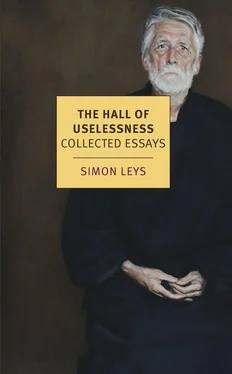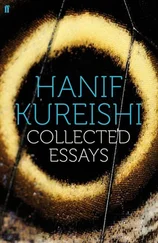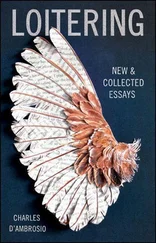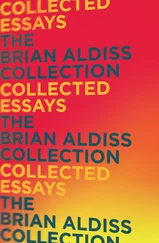In 1950, “the senile childishness” which Martin had already detected ten years earlier grew to disturbing proportions. One day, for instance, he agreed on the telephone to sign a manifesto — without knowing what the issue was (it concerned the admission of communist China into the United Nations). He cried out to his friends: “I understand absolutely nothing, I have no idea what the matter in question was!” The Tiny Lady concluded with despair: “This small anecdote is typical of his behaviour: ever more vague, unjustifiable, changing, illogical; he was already like that in the small things of life; what would you expect him to do now regarding the fate of Europe!”[190]
His friends loved him dearly; nevertheless, when he finally died, they breathed a sigh of relief. “He was less and less able to control his own actions; we were living in permanent fear of what the next day would bring. His exemplary death (honestly prepared for, but helped by a set of favourable circumstances) provided a majestic cover-up for everything. It came not a minute too soon!”[191]
SEXUALITY
Gide repeatedly confessed his puzzlement: “I shall die without having understood anything — or so little — of the physiology of my own body.” Or again: “I grow old without any hope of ever knowing my own body.”[192] One day, he explained to Martin du Gard with detached objectivity the physiological details of his sexuality.[193] In his own opinion, his condition was abnormal: “a physiological paradox,” “a pathological case.”
Yet, another time, he also confided to Martin his indignation and sorrow at often being accused of corrupting the young: “How unfair! How could it be perverse to initiate young people into sensual pleasure?” And he explained at great length that his role was always, first and foremost, that of a patient educator: “Nothing, during the troubled years of adolescence, can replace the beneficial influence of a liaison — sensual, intellectual and moral — with an elderly guide, worthy of trust and love.”[194] This is the theme he had developed in Corydon , but it had limited relevance to his own practices, for, in fact, what he called his “adventures” usually involved children, street kids, hotel grooms, little Arab beggars, diverse defenceless little wretches, furtively, in conditions that certainly left neither time nor space for any form of enlightened communication. The Tiny Lady observed: “One could not emphasise enough how odd his temperament is. His sensuality is so deep, so demanding, so tyrannical, ruling an entire part of his life — and yet it reaches its fulfilment so easily, so lightly, so quickly… It is bizarre to the point of defying belief. Seeing how devious he can be in order to attain the object of his desire, people naturally misjudge him, and they assume that he must be depraved in that same proportion. On the other hand, one can easily imagine what sort of fallacious pretexts he has to invent in order to justify his insinuating and hypocritical manoeuvres, when one considers how incredibly harmless are the actual activities in which they eventuate. It seems to me that these particular sexual dispositions are an important key for understanding Gide.”[195]
Eventually, the way in which he became a slave to his mania distressed even the friends who had originally shared his inclinations. Schlumberger concluded: “During his life, Gide’s concern was to win respect for homosexuals; yet, because of his particular obsessions, in the end, he succeeded only in bringing discredit to their cause.”[196]
Still, any person who happens to believe in the Christian faith that was originally Gide’s would be ill-qualified to censure his infirmities; for the fact is that we all belong to a fallen species; to varying degrees, innocence escapes us; one way or the other, we are all cripples. In Gide’s case, the contrast — extreme and tragic — between, on the one hand, the splendour of his intelligence and culture, the nobility of a mind open to all humanistic endeavours, and on the other, the grotesque and gruesome tyranny of his obsessions, is heart-breaking and should inspire compassion.
Yet, how can compassion be extended when its very need is being strenuously denied? For, after all, the real problem did not lie in Gide’s sexuality but in his tortuous relation to truth.*[197]
THE TINY LADY, MARIA VAN RYSSELBERGHE (1867–1959)
As her familiar nickname indicates, “la Petite Dame” was of diminutive stature. Her various portraits — painted by her husband, Théo Van Rysselberghe (1862–1926), and by another Belgian artist, Fernand Khnopff (1851–1921) — all reflect her vivacious and bewitching grace. Born and educated in Belgium like Théo himself, she followed him to France, where they settled in 1898. Théo, who had shown great talent at the beginning of his career, working in a free and robust style very similar to that of his schoolmate, James Ensor, eventually fell under the influence of Seurat and Signac; his art turned into a dogmatic and dreary application of the Pointillist formula and, unfortunately, did not live up to its earlier promise.
Théo loved his wife, but he seems to have been somewhat bewildered by her liberated behaviour. Maria had genuine affection for her husband; she considered him a good companion, but her own sentimental life developed in tranquil breach of all conventions. She refused to conform both to bourgeois order and to Bohemian disorder.
In 1896, she fell madly in love — for one season — with the great poet Verhaeren. This intense passion — which was reciprocated, but never consummated — was transposed by her, forty years later, into a short memoir, which is a pure and haunting masterpiece of narrative prose ( Il y a quarante ans ). Later on, she also had a liaison with the wife of a wealthy industrialist from Luxemburg; it was originally for the private enjoyment of her female friend that she began to write the chronicle of her years with Gide.
She first met Gide (who was a friend of Théo) at the end of the nineteenth century. As she was to recall: “He was then around the age of thirty… He was exceptionally attractive, his charm was overwhelming; most of all he had a deep originality: on no subject did he ever think like anyone else, not out of a taste for paradox, but simply because his vision was naturally new.”[198]
Over the years, Maria and Gide developed for one another an attachment that was singularly harmonious; their personalities were utterly dissimilar, but they shared the same passion for culture, the same hunger for books and ideas. Their odd intimacy was further strengthened when Maria — through her daughter Elisabeth — became the grandmother of Gide’s daughter,* to the distress of poor Théo, who had only a dim awareness of who the father of his daughter’s child might actually be.
Shortly after Théo’s death, Maria and Gide made arrangements that enabled them to spend the rest of their lives not exactly together, but side by side. They eventually moved into twin apartments, enjoying each other’s company, while retaining their parallel freedoms. This situation was to last until Gide’s death.
Their relations were a curious mixture of formality and closeness. For instance, Maria noted, seven years after they had settled into their joined existences: “Gide addressed me as ‘old chap’ [ mon vieux ]; it is the first time that such a thing has happened to him. He apologised at once.”[199] But in the end they became very much like many old couples: indestructibly linked by a long habit, made of deep affection — and of many small irritations.
Together with Martin du Gard and Herbart, the Tiny Lady formed the triumvirate that endeavoured to steer with vigilant solicitude Gide’s erratic course in his later years. As she was closest to him, she played the most important role. Her intelligence, culture and sound critical judgement had turned her into an invaluable reader and literary adviser for Gide. Besides, her feminine common sense and sang-froid made her indispensable in the handling and resolution of all the practical problems of everyday life — at which Gide was uniformly inept. And she even, in the final years, performed for him — with the cool detachment of a professional nurse — some services of a more intimate nature, “when no Annamite young boy could be found in the street.”[200]
Читать дальше












